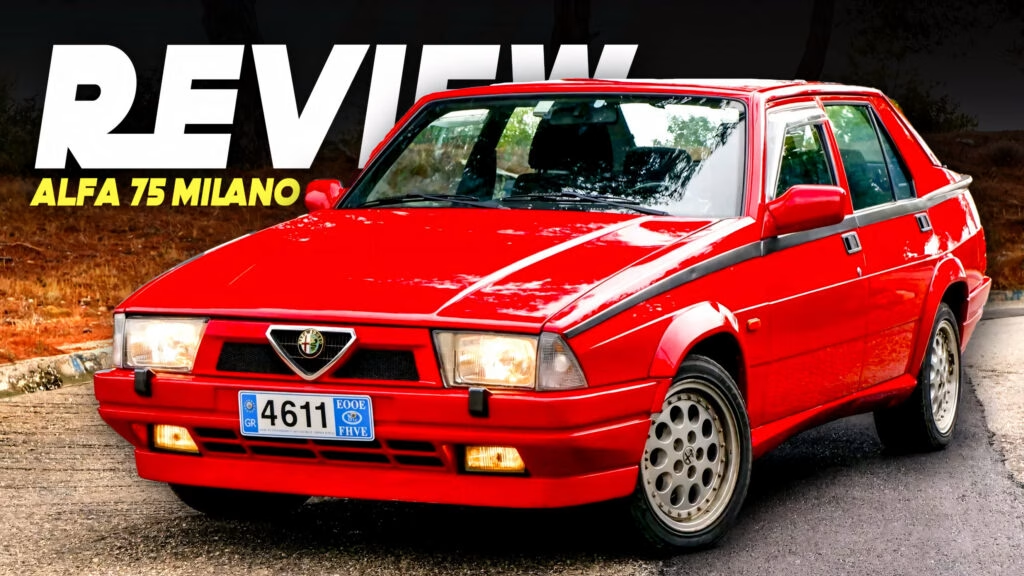Before crossovers became the norm and the term “sporty” was often synonymous with faux exhausts and paddle shifters, Alfa Romeo was crafting something truly unique. Enter the Alfa 75, or as it was known in North America, the Milano. This compact sedan, with its rear-wheel drive and nearly perfect 50:50 weight distribution, stands out as a significant chapter in Alfa’s history, marking the last new model introduced before Fiat took the reins in 1986.
A Personal Connection to the Alfa 75
When my friend Stelios offered me the keys to his beloved 1992 Alfa 75, saying no wasn’t really an option. Stelios has a deep-rooted passion for Alfa Romeos, and this particular model is his fourth 75, complementing his meticulously maintained 1976 Alfetta. While the Alfetta mostly enjoys retirement in the garage, the 75 is about to embark on a new journey as a daily driver.
Stelios’s decision to sell his Mazda MX-5 NC in favor of the Alfa piqued my curiosity even more. Both cars share a rear-wheel-drive layout and boast similar weight-to-power ratios—key ingredients for driving enjoyment. But before diving into the driving experience, let’s take a closer look at the specs that make the Alfa 75 a standout.
Quick Facts About the Alfa 75
– **Model:** 1992 Alfa Romeo 75 2.0 Twin Spark
– **Production Years:** 1985-1992
– **Dimensions:** 4,331 mm (170.5 in) length, 1,631 mm (64.2 in) width, 1,349 mm (53.1 in) height, 2,510 mm (98.8 in) wheelbase
– **Curb Weight:** 1,150 kg (2,535 pounds)
– **Layout:** Front engine, rear-wheel drive
– **Engine:** Naturally aspirated 2.0-liter four-cylinder
– **Output:** 146 hp (109 kW / 148 PS)
– **Gearbox:** Five-speed manual
A Unique Blend of Style and Function
Launched in 1985 as the successor to the Giulietta sedan, the Alfa 75 remained in production until 1992, just before the brand shifted to front-wheel drive with the 155. Interestingly, it wasn’t until 2015 that Alfa Romeo returned to rear-wheel drive with the Giulia, reconnecting with its performance roots.
The 75 was designed to compete with the likes of the BMW 3-Series, specifically the E30 and E36. However, it carved its own niche with a design that can be both stunning and awkward, depending on the viewer’s perspective. The 1992 facelifted model, with its body-colored bumpers and iconic “phone-dial” wheels, is one of the tidiest iterations of this classic.
Inside the Alfa 75: A Quirky Time Capsule
Stepping into the cabin of the Alfa 75 feels like entering a time capsule. The ergonomics are, well, unique. For instance, the window switches are located on an overhead panel, which can catch passengers off guard. The handbrake, wrapping around the center armrest, looks like something out of a Cold War fighter jet. The instrument cluster, with its blocky dials, is pure 1980s nostalgia, paired with a diagnostics panel that was cutting-edge tech at the time.
Despite its quirks, the interior feels solid, and the driving position is well thought out. The rear bench offers ample space for passengers, and at 4,331 mm in length, the 75 is compact by today’s standards, especially compared to the many SUVs dominating European roads.
Driving Dynamics: A Sports Car in Disguise
The Alfa 75 is built on an upgraded version of the Alfetta’s chassis, achieving a remarkable 50:50 weight distribution by cleverly mounting the five-speed manual gearbox and clutch within the rear differential. This transaxle setup is quite rare for a sedan, enhancing its handling characteristics.
To further refine its dynamics, Alfa engineers incorporated inboard rear brakes and a de Dion rear axle. This platform also underpinned the more expensive Alfa Romeo SZ by Zagato, giving 75 owners a legitimate reason to boast about their vehicle.
This particular model is powered by the reliable 2.0-liter Twin Spark four-cylinder engine, delivering 146 hp and 186 Nm of torque. It’s a step up from the base 1.6-liter engine, providing a more engaging driving experience without the weight of the larger 3.0-liter V6 Busso.
Behind the Wheel: Pure Driving Joy
Even with 150,000 km (93,200 miles) on the clock, the engine of Stelios’s Alfa 75 sounds and feels fantastic. The startup noise and the old-school throttle response create an analog charm that instantly excites. From the first few corners, it’s clear that the Alfa has a balanced, neutral setup. The chassis feels more rigid than expected, and the suspension absorbs rough patches with surprising composure.
One of Stelios’s modifications includes adjustable Koni springs, giving the car a sportier feel than you’d typically expect from a classic sedan. Coupled with Toyo Proxes R1R semi-slicks on the stock 15-inch wheels, the 75 becomes playful and tail-happy on twisty roads—exactly the kind of behavior you want in a weekend car.
Despite a minor quirk with the hydraulic steering, which can feel heavier than it should, the Alfa 75 proves to be genuinely enjoyable. The naturally aspirated engine has ample power for relaxed highway cruising, and the soundtrack from the center-mounted exhaust adds character at any speed.
As I navigated the tight, winding roads of the Mediterranean countryside, bathed in the warm glow of the setting sun, I finally understood why Stelios cherishes his Alfa Romeo so much. It’s a car that invites you to keep driving. While it may not have the razor-sharp steering of the 156 or the sculpted curves of the Brera, the 75 possesses a charm all its own.
The big takeaway? The Alfa 75 isn’t just a classic; it’s a reminder of what driving used to feel like—pure and unfiltered. If you’re considering a classic car, take a page from Stelios’s book. Embrace the quirks, enjoy the ride, and you might just find yourself falling in love with driving all over again.

